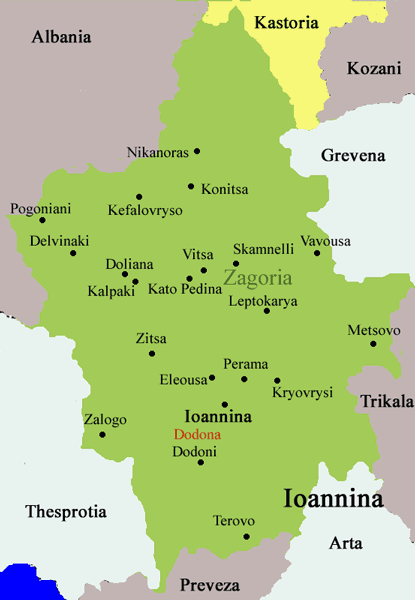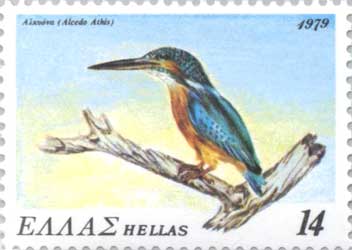|
|
Zagori is an area in the Pindus mountains in Epirus, northwest Greece. It has an area of some 1000 square kilometers and 45 villages called Zagoria or the Zagorohoria, and is in the shape of an upturned equilateral triangle. The southern vertex of the triangle is the provincial capital, Yannena (Ioannina); the south-southwest side is formed by the mountain Mitsikeli (1810m); the Aoos river and Mt Tymphe constitute the northern side, and the east-southeast side runs along the Varda river to Mt Mavrovouni (2100m) near Metsovo. According to the most recent figures (which are nonetheless a fairly dubious maximum) the population of the area is about 5000, which gives a population density of 5 inhabitants per square kilometer as opposed to an average of 73.8 for Greece as a whole. History It is not so long ago, the fact that an area was mountainous and difficult of access, far from being a disadvantage, was a factor conducive to security and stability. In contrast to the rest of Greece, which witnessed the passage of one conqueror after another, Zagori heard only the distant rumble of the rise and fall of petty kingdoms; there were no invasions or forcible changes in the compo-sition of its population. One result of this is that the Sarakatsan people, who occupy a part of the area, are, according to the archaeologists, direct descendants of the inhabitants of Zagori in Neolithic times, before the Dorian invasion. Zagori was a part of the ancient kingdom of Molossoi an Epirote tribe dwelling in the north, who succeeded in gaining control over all of Epirus in late Classical times. They were best known for a breed of huge war-mastiffs they used in military operations. Molossus, their eponymous ancestor, was said to have been born of a union between Neoptolemus (son of Achilles ) and Andromache (Hector s' of Troy wife). Olympias, the mother of Alexander the Great, was from the ancient town of "Molossida" which was located in the area in front of Konitsa, where the rivers Voidomatis, Aoos and Sarantaporos join together. Here, Pyrrhus, King of Epirus, built his castles. Later on, the Egnatia Avenue that was build by the Romans passed this area. Nearby Vitsa s' village one can find the remains of a neolithic settlement of Molossoi dated to the 9th until the 4th century B.C. Under the Byzantine Empire the security which Zagori could afford attracted from time to time groups of soldiers who built villages and settled there. The same process also occurred in Turkish times: the mountains were never really conquered by the Ottoman Empire and were a place of safety for Greeks on the run from the authorities. In more recent times, the refugees from the Asia Minor catastrophe never penetrated as far as Zagori; but that has certainly proved not to have been to the region's advantage. When Epirus fell to the Turks in 1430, Zagori (which then consisted of 14 villages as the others were founded at later dates) «bowed the knee», which meant in practice that there were obligations between delegations of the two sides and a sum in tax was agreed upon in exchange for very considerable privileges: autonomy, administrative independence, and a ban on Turks crossing the borders into the area. This solution suited the conquerors and was also the salvation of Zagori, for to the geographical factors which make it a natural refuge were now added statutory rules. The consequences of this are not difficult to imagine. Zagori was never broken up and shared out among Turkish landowners; on the contrary, it gained a large population of merchants whose links were with Romania, Russia and Constantinople, who were con-stantly on the move and often absent, who came to be the ruling class of the area and contributed to the prosperity Zagori enjoyed throughout the period of Turkish rule. This prosperity reached its height during the 18th century; schools for both boys and girls were built, mills to grind the corn rose, the water supply was graced with ornamental fountains and medicine flourished in the form of «Vikos-doctors», who gathered the herbs for their preparations from the gorge. There was even talk of setting up a university. The Vikos gorge The Vikos Gorge, one of the gorges of Zagori located in the Vikos-Aoos National Park, stands out from all the others for its dimensions and for its awe-inspiring beauty. The gorge collects the waters of a number of small rivers and leads them into the Voidomatis which rises in the Gorge. The Vikos Gorge is one of the deepest gorges in the world, second only to the Grand Canyon in Arizona. In fact, the walls of the Vikos gorge, at about 1.040 m (3,120 ft) at places, are the steepest anywhere. As a natural phenomenon, it has to be seen to be believed. Over and above its grandeur, however, the Vikos Gorge is of a major scientific interest because it is in almost virgin condition and its ecosystems are many and various. This is one of the reasons for which it forms the heart of the Vikos-Aoos National Park, which is a refuge for many endangered species of animal. Despite the undoubted passage of the Slavs as testified to by numerous placenames changes in the human element in Zagori have come about exceptionally slowly, and to talk of real continuity of population is no exaggeration. Zagori villages (Zagorohoria) This is a list of Zagori villages in alphabetical order.
Monodendri, Zagori
Kato Pedina (old name Kato Soudena), Photo: User:Houlio
 |
|||||||||||||||
|
|




